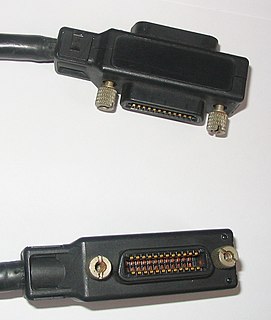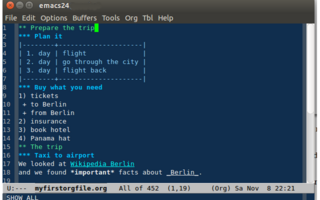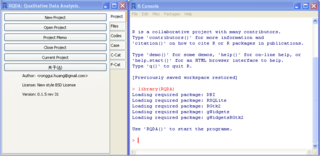
AutoCAD is a commercial computer-aided design (CAD) and drafting software application. Developed and marketed by Autodesk, AutoCAD was first released in December 1982 as a desktop app running on microcomputers with internal graphics controllers. Before AutoCAD was introduced, most commercial CAD programs ran on mainframe computers or minicomputers, with each CAD operator (user) working at a separate graphics terminal. AutoCAD is also available as mobile and web apps.
The Protein Data Bank (PDB) is a database for the three-dimensional structural data of large biological molecules, such as proteins and nucleic acids. The data, typically obtained by X-ray crystallography, NMR spectroscopy, or, increasingly, cryo-electron microscopy, and submitted by biologists and biochemists from around the world, are freely accessible on the Internet via the websites of its member organisations. The PDB is overseen by an organization called the Worldwide Protein Data Bank, wwPDB.

IEEE 488 is a short-range digital communications 8-bit parallel multi-master interface bus specification developed by Hewlett-Packard as HP-IB. It subsequently became the subject of several standards, and is generically known as GPIB.

An outliner is a specialized type of text editor used to create and edit outlines, which are text files which have a tree structure, for organization. Textual information is contained in discrete sections called "nodes", which are arranged according to their topic–subtopic (parent–child) relationships, like the members of a family tree. When loaded into an outliner, an outline may be collapsed or expanded to display as few or as many levels as desired.
Euclid is a CAD software which has been developed since 1970. Initially written by Jean Marc Brun and Michel Théron at Laboratoire d'informatique pour la mécanique et les sciences de l'ingénieur (LIMSI) for modelling fluid flow, they founded their own company, Datavision in 1979 and then sold a controlling interest in 1980 to the French company Matra Datavision.
Throughput of a network can be measured using various tools available on different platforms. This page explains the theory behind what these tools set out to measure and the issues regarding these measurements.

QCAD is a computer-aided design (CAD) software application for 2D design and drafting. It is available for Linux, Apple macOS, Unix and Microsoft Windows. The QCAD GUI is based on the Qt framework.

STL is a file format native to the stereolithography CAD software created by 3D Systems. STL has several backronyms such as "Standard Triangle Language" and "Standard TessellationLanguage". This file format is supported by many other software packages; it is widely used for rapid prototyping, 3D printing and computer-aided manufacturing. STL files describe only the surface geometry of a three-dimensional object without any representation of color, texture or other common CAD model attributes. The STL format specifies both ASCII and binary representations. Binary files are more common, since they are more compact.

Windows Photo Viewer is an image viewer included with the Windows NT family of operating systems. It was first included with Windows XP and Windows Server 2003 under its former name. It was temporarily replaced with Windows Photo Gallery in Windows Vista, but was reinstated in Windows 7. This program succeeds Imaging for Windows. In Windows 10, it is deprecated in favor of a Universal Windows Platform app called Photos, although it can be brought back with a registry tweak.

OrCAD Systems Corporation was a software company that made OrCAD, a proprietary software tool suite used primarily for electronic design automation (EDA). The software is used mainly by electronic design engineers and electronic technicians to create electronic schematics, perform mixed-signal simulation and electronic prints for manufacturing printed circuit boards. OrCAD was taken over by Cadence Design Systems in 1999 and was integrated with Cadence Allegro since 2005.

Rhinoceros is a commercial 3D computer graphics and computer-aided design (CAD) application software that was developed by Robert McNeel & Associates, an American, privately held, and employee-owned company that was founded in 1980. Rhinoceros geometry is based on the NURBS mathematical model, which focuses on producing mathematically precise representation of curves and freeform surfaces in computer graphics.

ST Amiga Format was a computer magazine that covered the Atari ST and Amiga computers. It was published by Future plc to cover the ever growing market for the, then-new, 16-bit home computers. Issues were equally balanced with coverage for both Commodore Amiga and Atari ST systems. Issue 1 included a main feature 'ST or Amiga? The Choice is Yours', where the pros and cons for each machine was examined.

Digital sheet music is technology for representing and displaying sheet music in a computer-readable format. With the emergence of several technological innovations, sheet music evolved in several stages into what was to be termed digital sheet music.
ISO 13399 is an international technical standard by ISO for the computer-interpretable representation and exchange of industrial product data about cutting tools and toolholders. The objective is to provide a mechanism capable of describing product data regarding cutting tools, independent from any particular system. The nature of this description makes it suitable not only for neutral file exchange, but also as a basis for implementing and sharing product databases and archiving, regarding cutting tools.

Claris CAD was a two-dimensional computer-aided design program for Apple Inc. Macintosh.
Camtasia is a software suite, created and published by TechSmith, for creating and recording video tutorials and presentations via screencast, or via a direct recording plug-in to Microsoft PowerPoint. Other multimedia recordings may be recorded at the same time or added separately. Camtasia is available in English, French, German, Japanese, Portuguese, Spanish and Chinese versions.
The table below provides an overview of notable computer-aided design (CAD) software. It does not judge power, ease of use, or other user-experience aspects. The table does not include software that is still in development. For all-purpose 3D programs, see Comparison of 3D computer graphics software. CAD refers to a specific type of drawing and modelling software application that is used for creating designs and technical drawings. These can be 3D drawings or 2D drawings.
This is an overview of notable viewers for files, that are produced by Computer aided design (CAD), Computer-aided manufacturing (CAM) and Computer-aided engineering (CAE) applications.
3D computer graphics software refers to programs used to create 3D computer-generated imagery.

RQDA is an R package for computer assisted qualitative data analysis or CAQDAS. It is installable from, and runs within, the R statistical software, but has a separate window running a graphical user interface. RQDA's approach allows for tight integration of the constructivist approach of qualitative research with quantitative data analysis which can increase the rigor, transparency and validity of qualitative research.











